Viennese timpani
Re-publication of a web article from 2002
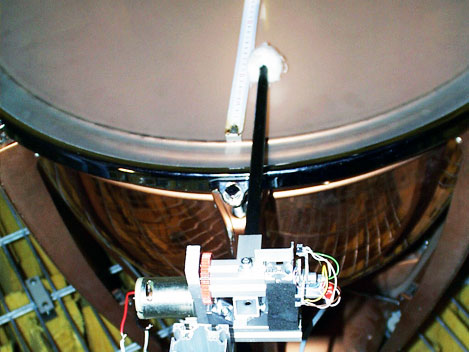
In principle, in Vienna, goatskins are used for all types of membraneophones (plastic skins are used worldwide). The natural skin produces a specific sound and requires an appropriate playing technique and mallets. The "Viennese Timpani" (Hochrainer model) has a hand lever system instead of the pedal system used worldwide. In addition, the kettle is pressed against the skin as a movable part during tuning. With the internationally common pedal timpani it is the other way round: the skin stretched in a ring is pressed against the kettle. Although the different construction makes a big difference for the musicians in terms of operation and playing technique, it contributes in no way to the very special sound of the Viennese timpani.
Basic information on the acoustics of the timpani
- The sound of the timpani is primarily determined by the vibrations of the skin.
- The pitch increases with the tension of the skin.
The skin (like the string of a violin) vibrates particularly well at certain frequencies according to its tension and mass. However, since the skin is a surface, unlike the string, which vibrates only in one way, there are two different types of vibration which are present simultaneously (see Fig. 1):
- radial modes
- circular modes
As with all musical instruments, the timbre of the timpani is determined by the number and strength of the partials (overtones). These, in turn, are produced by the modes (= forms of vibration of the skin).
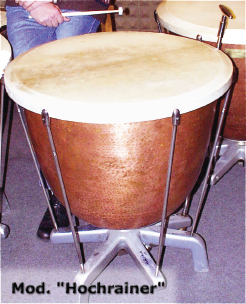
In contrast to string and wind instruments, in which the partials contained in the sound are all in a whole number ratio to the lowest vibration (= fundamental), the timpani sound forms many partials which do not have an integer relationship to the lowest vibration. These partials make it difficult to determine the exact "pitch" of a timpani sound and are responsible for the "noise component" in the timpani sound.
The decay time of the radial modes is longer (approx. 1.5 sec.). An approximately harmonic structure, as it is common with musical instruments, can be observed. This modes are decisive for the perceived pitch of the produced sound.
The circular modes, on the other hand, decay very quickly (0.2 - 0.3 sec.) and their frequencies do not fit into a harmonic grid. They are responsible for the noisy character of the timpani sound.
A mode of oscillation is usually indicated by two digits. The first digit indicates the ordinal number of the radial mode (is responsible for the pitch), the second digit that of the circular mode (noise). Fig. 2 shows the first 3 of the two types of vibration separately. In nature, both modes always occur simultaneously (mode 12 in Fig. 2).
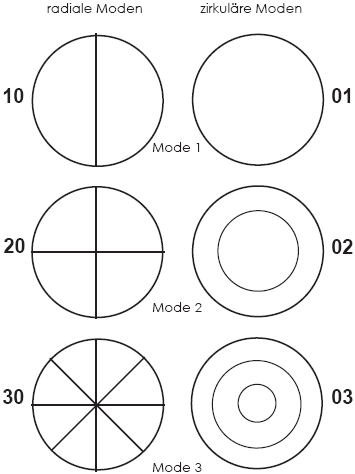
Fig. 1: radial and circular modes
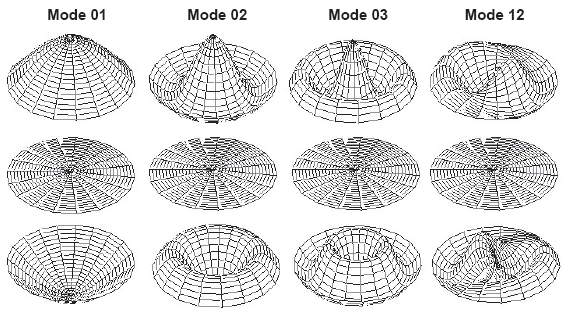
What is the difference between Viennese timpani with goatskin and international timpani with plastic skin?
The sound of the Viennese timpani has a stronger "tonal character", the international timpani has a more noisy character.
Figures 3 and 4 show a 3D analysis of timpani beats (medium type). The time runs from back to front, the frequency from left to right and the amplitude (strength) is plotted on the vertical axis. The individual partials can be recognized as "mountain ridges" that become lower with time. The fundamental (mode 11) is marked black, the fifth (mode 21) is blue and the octave (mode 31) is marked red.
It can be clearly seen that the harmonic, integer multiple (radial) modes of the Viennese timpani (Fig. 3) are more pronounced than those of the international timpani (Fig. 4). Many inharmonic partials in the sound and beatings in the international timpani reinforce the percussive character.
Table 1 presents a comparison of the amplitude of the fundamental tone (i.e. the deflection of the timpani skin of Mode 11 in nanometers), measured with laser interfereometry. For Viennese models, the fundamental is significantly more strongly represented in the sound spectrum. The difference is particularly pronounced in the smaller timpani kettles.
- The sound of the Viennese timpani is somewhat more modulation capable.
- The goatskin reacts more strongly to different head and mallet materials.
- However, natural skins have the disadvantage of reacting extremely strongly to changes in humidity.
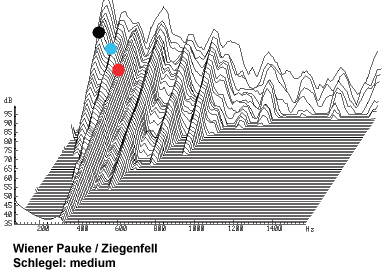
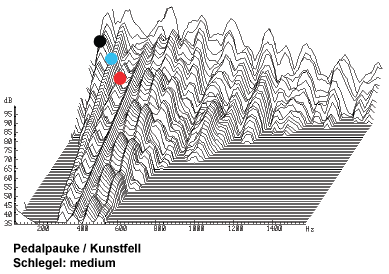
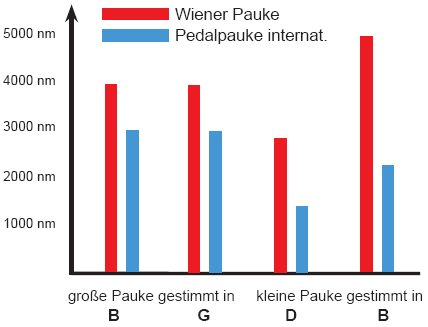
Small drum
Similar to the timpani, the small drum also uses goatskin. In addition, a strongly damped fastening system is preferred, which draws less vibration energy than conventional tripods.
In extreme cases, the small drum can also be mounted on a wooden chair. Sound differences are audible and extensive vibration tests are planned.
Cymbals
Original instruments of the company Avedis Zildjan (Constantinople) are still used here. These "Turkish cymbals" were made in the 19th and 20th century.
The differences lie not only in the material, but above all in the manufacture: While conventional contemporary instruments are made of sheet metal, these original Zildjan cymbals were cast and then turned to their original shape.